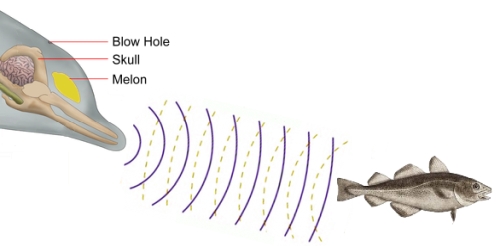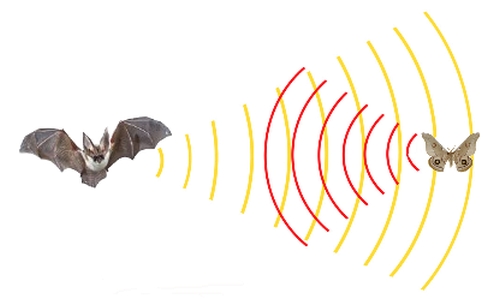  Echolocation is used by bats, dolphins, some whales, and other animals to determine the location of objects using reflected sound. This allows the animals to move around in darkness, communicate with others, and find things to eat. Killer whales, for example, use it to find and track their prey. Dolphins and toothed whales use echolocation by bouncing high-pitched clicking sounds off underwater objects, similar to shouting and listening for echoes. The sounds, sometimes at frequencies as high as 200,000 hertz, are made by squeezing air through nasal passages inside the blowhole. These soundwaves then pass into the forehead, where a big blob of fat called the melon focuses them. If the sounds hit something, the reflected sound is picked up through the animalís lower jaw and passed to its ears. Dolphins and whales use this method to work out an objectís distance, direction, speed, density and size. Dolphins can detect an object the size of a golfball at a distance of 100 metres. By moving its head to aim the sound beam at different parts of a fish, a dolphin can even differentiate between species!  As mentioned, Killer whales (Orcas) depend on this ability to navigate, communicate, and hunt prey. They echolocate by producing clicks and then interpreting the received echoes. The echolocation clicks are at frequencies between 45,000 and 8,0000 Hz. The clicks pass through the melon located in the whale's forehead, which acts as a lens to focus the sound waves into a beam, which is then projected forward into the water in front of the whale. The travelling sound waves bounce off objects in the water, and their echoes will reflect back to the whale. The echoes are received by the lower jaw, which focuses the 'image' of the object and sends it to the middle ear bones, the inner ear, and finally to the brain, where it is interpreted. Bats make echolocating sounds in their larynxes and emit them through their mouths. Most of these sounds, while very loud, are too high-pitched for humans to hear. Some bats use frequencies as high as 212,000 hertz. Bats can detect a flying insect up to 5 metres away, work out its size and hardness, and can also avoid obstacles in its path. To avoid being deafened by its own calls, a bat can actually turn off its middle ear as it calls, restoring its hearing a split second later to listen for the echoes.  Other animals can also echolocate. Some nocturnal shrews use ultrasonic squeaks to explore their dark surroundings. Hedgehogs may use ultrasonic whistles. Humans who are blind can sometimes learn to avoid obstacles by listening to echoes bouncing off their surroundings. |